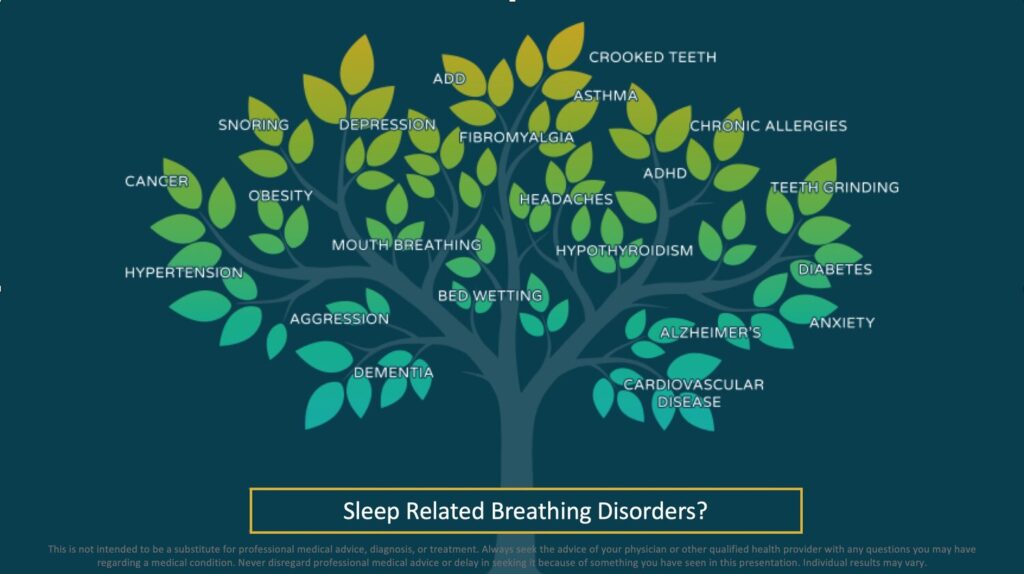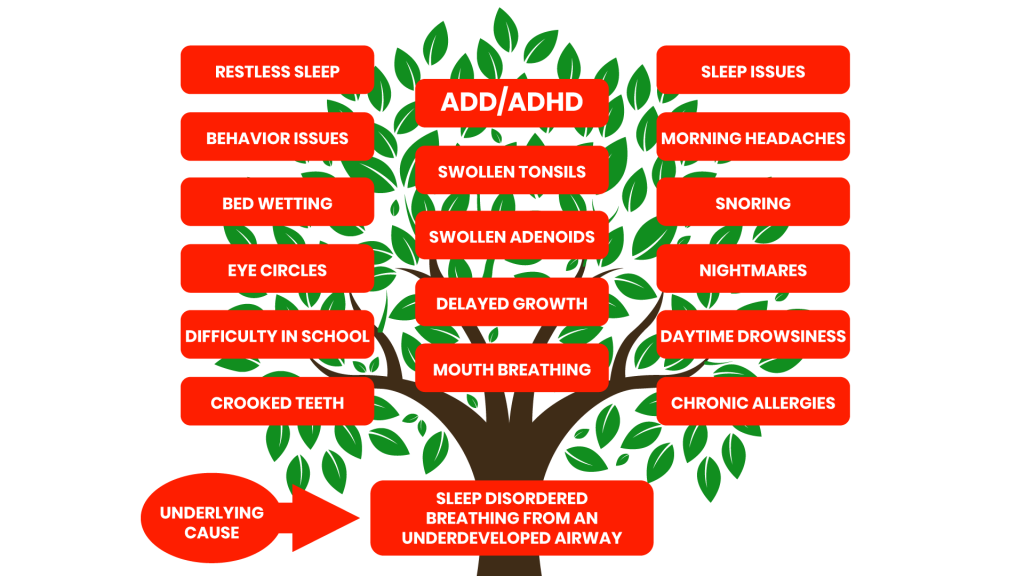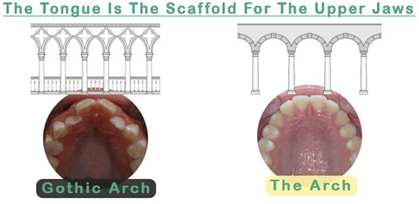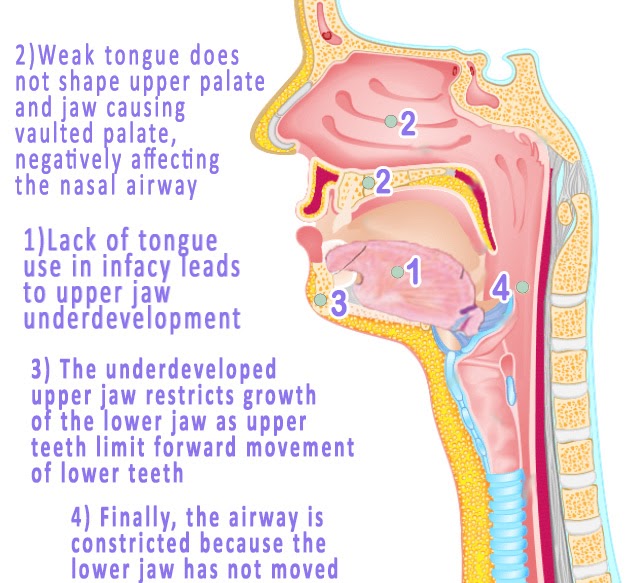
The silent crisis among our children today is a pervasive, yet debilitating condition that affects nearly all of them. Most troublingly, it’s one which often goes unnoticed due to the fact that many are too young to know what they’re feeling or don’t have the vocabulary for their feelings. An estimated 9 out of 10 American kids struggle with these three symptoms:

With such a high number of children in our communities being affected by these symptoms, doctors started to look at what could be the root cause. Sleep disordered breathing (SDB) is an all-inclusive term for breathing difficulties, which can range from mild snoring to severe obstruction during sleep. When your child’s body recognizes it similarly as choking and their brain sends an automatic response towards wake up so they are able breathe again ultimately disrupting their sleep cycle. Poor sleep will show the next day, and over time can lead to other symptoms such as difficulty in school, chronic allergies or even misdiagnosis of ADHD/ADD.
What Happens to Your Body if you don’t get enough sleep?
Schedule An AppointmentWhy would SDB be affecting my child?
SDB is a condition that can cause sleep apnea, which will have negative effects on them.
Lucky for us, we have science and research to help us answer this question. The reasons for this are studied in depth by Dr. Robert Corruccini, who found that the human skull from 400 years ago had a large upper and lower jaw with room to fit all 32 teeth on average without them being crooked or crowded together like they are today.
A human skull is a marvel of evolution, adapting to changes in our environment and lifestyle during the course of time. 400 years ago skulls had plenty of space for all 32 teeth without any crooked or crowded teeth. The modern day has changed this with just 28 tooth spaces, leaving some people missing out on an entire molar row!
A jaw bone resembles that of other animals like crocodiles and whales- they are made up mostly from cartilage which is soft tissue composed mainly from collagen fibers. This material allows the shape change needed as we get older so it can fit comfortably over your upper plate when you close those pearly whites together securely – but what if there’s not enough room?
In dentistry, we call crooked and crowded teeth malocclusion. Dr. Corruccini then studied isolated, rural populations all over the world who weren’t exposed to things like baby formula and processed foods for many years before they were adults or didn’t have contact with them at any time in their lives. Doing this research showed that these people breastfed – some as long as 2-3 YEARS! He found that when he looked into what diet was prevalent during infancy (made up of hard root vegetables and dried meat), And their diet from infancy was made up of hard, tough foods like root vegetables and dried meat. After looking at his findings, he came to 3 conclusions:
Dietary consistency and toughness promote proper bone growth
When non-resistant, processed food became common after the Industrial Revolution, the rate of crooked and crowded teeth went up
Soft diet and processed foods increase underdevelopment of the upper and lower jaws, this leads to crooked and crowded teeth
Dr. Corruccini discovered that the introduction of processed foods and soft diets in rural populations led to an increase in crooked teeth (malocclusion) after one generation, which rose to 70% by three generations later.
What’s the significance? Normally it takes 27,000 years for a genetic mutation to express itself in 51% of our population. So how did malocclusion show up in half of the rural populations just one generation ago? This tells us that crooked teeth are not inherited and there is no such thing as good or bad genes after all! To bring this home, what caused those crowded mouths was cultural changes; changes like dieting habits which cause many people living with ancestral eating habits were suddenly faced with processed food diets full of sugar and refined carbohydrates.
Western Cultural Influence

inadequate
breastfeeding

Bottle
Feeding

Soft
Diet
We will now explore the importance of an individual’s tongue. Tongues are what allow us to speak and taste our food – it acts as muscle for swallowing, chewing, and speaking.

When a child’s tongue is not strong, they end up with an improper U-shaped arch and crowded teeth. But when their tongue is stronger, it will be able to function properly and give them the proper V-shape that has room for all of their permanent teeth without any problems!
With a better understanding of the airway, it’s important to remember that if there is an underdeveloped upper jaw this will affect both the nasal passage and lower jaw. The teeth are trapped by their neighbor on each side which prevents them from growing forward properly.

With our new knowledge about how sound travels through your nose or mouth (see diagram below), we can see why certain sounds come out at different tones such as when you have allergies making everything in your throat scratchy or make speaking difficult because they block off some parts of what should be open for us to use speech effectively.
When the lower jaw cannot expand forward to where it needs, children’s airways may not grow as they should. This leads to restless sleep and insufficient oxygen for normal bodily function eventually leading up to sleep problems with other symptoms on what is called a symptom tree appearing over time.
We can now make a direct connection to how some of the symptoms on the tree are related to sleep disordered breathing. But, what about ADD/ADHD, chronic allergies and bedwetting?
ADD/ADHD & SDB
A child who doesn’t get a proper night’s sleep with a good quality of breathing throughout the entire night is going to wake up unrested. When children don’t have enough deep, uninterrupted rest makes them cranky and unfocused. In school – they often end up being diagnosed as having ADHD!
A lack of adequate shut eye prevents our brains from getting vital oxygen during REM sleep which can cause fatigue or even mood problems like depression. But also when we are constantly interrupted by shallow breaths at home that means less of a chance for us to learn how to regulate our own respiratory system – leaving children feeling out of control and effecting them at school.

The doctor’s solution for children diagnosed with ADD/ADHD is a pharmaceutical stimulant. The child may be sitting still, but the condition doesn’t improve their academics because it ignores the underlying problem of sleep deprivation in those same children.
Current and past research shows that sleep deprived kids produce symptoms identical to ADHD diagnostic criteria – the difference being that these kids will grow out of their hyperactivity when they catch up on lost zzzzs!
CHRONIC ALLERGIES

Allergies, when they are not taken care of properly and with a cure for the allergy itself can have effects on your child’s ability to sleep. This is because allergies create nasal congestion which dries out their mouth or blocks their airway leading them to experience “apneas” in which temporary breathing stops resulting in obstructive sleep apnea (OSA).
Allergic reactions interfacing with SDB/OSA includes allergic reactions interfering with regular healthy sleeping habits due to increased mucus production as well as dryness that causes snoring and interrupted airflow during an episode of nighttime oxygen deprivation. Allergies can affect the quality of restful sleep. For example, allergies might cause tonsils or adenoids to swell up as a result of mouth breathing and lead to OSA in some cases with surgery being necessary. However, when children breathe through their nose they produce nitric oxide which helps protect against pathogens such as fungi, viruses, and parasites.
BEDWETTING
It’s a common misconception that bedwetting is the result of laziness or carelessness. The truth, however, is quite different! It turns out that sufferers are simply victims to a much more sinister force: OSA (obstructive sleep apnea).

DELAYED GROWTH
Sleep disorders that interrupt deep sleep may decrease growth hormone secretion.

IS THERE A SOLUTION?
Introducing the Vivos Treatment: The solution to childhood sleep disordered breathing.
The Vivos Therapeutics System for children is non-surgical, low cost and FDA approved. It helps plan the upper jaw development of your child so that they have enough room in their mouth when new teeth erupt as well as future growth. Once those are properly developed, then airway issues will be less likely to come up due to it being able to grow fully without obstruction. The treatment itself consists of a special removable device (like a retainer) that is worn at night for about 12 to 24 months.
Now there is a way to achieve natural jaw and airway growth through the Vivos oral appliance that has the additional benefits of correcting your child’s smile (no need for braces) and other issues we’ve discussed. The first step to treatment is analyzing your child’s airway, working with you to find a financial plan that works best for you or maybe yourself if needed. If interested in an analysis contact us at (818) 776-1236 or email info@32ology
Schedule An Appointment